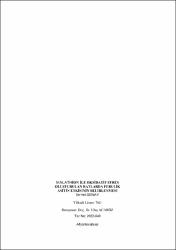Malathion ile oksidatif stres oluşturulan ratlarda ferulik asitin etkisinin belirlenmesi
Özet
Malathion yaygın olarak kullanılan organofosfatlı bir pestisittir. Bu madde, zirai alanda yararları olduğu kadar biliçsiz kullanımı halk sağlığını ve ekosistemi olumsuz etkileyecek zararlara da neden olabilir. Bu çalışmada malathion ile oksidatif stres oluşturan ratlarda, ferulik asitin olası koruyucu etkisinin araştırılması amaçlandı. Çalışmada 42 adet Wistar Albino Rat kullanıldı ve altı farklı grup oluşturuldu; Birinci Grup negatif kontrol, 2. grup yağ grubu, 3. grup pozitif kontrol (30 gün boyunca oral yolla 27 mg/kg dozunda malathion verildi.) olarak belirlendi. Ayrıca diğer 4, 5, 6. gruplara da 30 gün süreyle, günde bir defa olacak şekilde oral yolla 27 mg/kg malathion ile beraber sırasıyla günde 12,5 mg/kg, 25 mg/kg, 50 mg/kg dozunda gastrik gavaj yoluyla ferulik asit uygulandı. 30 gün süren çalışmanın sonucunda ratlardan alınan kan, kalp, karaciğer, böbrek, beyin, akciğer ve testis dokularında antioksidan enzim aktiviteleri (SOD, CAT), lipid peroksidasyon (MDA), glutatyon (GSH) değerleri analiz edildi ve histopatolojik incelemeler gerçekleştirildi. Ayrıca ratlardan alınan karaciğer ve böbrek doku örneklerinden IFN- γ, TNF-α ve NFkB proinflamatuvar genlerinin moleküler analizi gerçekleştirildi. Malathion uygulaması antioksidan enzim aktivitelerinde azalmaya neden oldu. Ayrıca, malathion uygulaması glutatyon seviyelerinide azalmaya neden olurken lipid peroksidasyon seviyelerini yükseltti. Proinflamatuvar genlerin ekspreyon düzeylerinde artışa neden oldu ve dokularda histopatolojik değişikliklere neden oldu. Ferulik asit uygulaması bu olumsuz etkileri tersine çevirdi ve en yüksek etkisi 50 mg/kg dozda görüldü. Çalışma sonucunda, malathion tarafından indüklenen oksidatif strese karşı doğal antioksidan olan ferulik asitin etkili bir koruyucu olduğu tespit edildi Malathion is a widely used organophosphate pesticide. While this substance has benefits in the agricultural field, its unconscious use may also cause harm that will adversely affect public health and the ecosystem. In this study, it was aimed to investigate the possible protective effect of ferulic acid in rats that caused oxidative stress with malathion. In the study, 42 Wistar Albino Rats were used and six different groups were formed; Group 1 was determined as negative control, Group 2 as oil group, Group 3 as positive control (27 mg/kg malathion was given orally for 30 days). In addition, the other 4th, 5th, and 6th groups were administered orally, once a day for 30 days, with 27 mg/kg malathion and ferulic acid was applied by gastric gavage at a dose of 12.5 mg/kg, 25 mg/kg, and 50 mg/kg per day, respectively. As a result of the study that lasted for 30 days, antioxidant enzyme activities (SOD, CAT), lipid peroxidation (MDA), glutathione (GSH) values were analyzed and histopathological examinations were performed in blood, heart, liver, kidney, brain, lung and testes tissues taken from rats. In addition, molecular analysis of IFN-γ, TNF-α and NFkB proinflammatory genes was performed from liver and kidney tissue samples taken from rats. Malathion application caused a decrease in antioxidant enzyme activities. In addition, malathion administration caused a decrease in glutathione levels and increased lipid peroxidation levels. It caused an increase in the expression levels of proinflammatory genes and caused histopathological changes in tissues. Ferulic acid administration reversed these negative effects and the highest effect was seen at 50 mg/kg dose. As a result of the study, it was determined that ferulic acid, a natural antioxidant, has a protective effect against oxidative stress induced by malathion.
Bağlantı
https://hdl.handle.net/11630/10210Koleksiyonlar
- Yüksek Lisans Tezleri [635]



















